Plasmon-Enhanced High-Order Harmonic Generation of Open-Ended Finite-Sized Carbon Nanotubes with Vacancy Defects
Abstract
:1. Introduction
2. Methods
3. Results
3.1. The Plasmon-Enhanced HHG of Intact Carbon Nanotubes
3.1.1. Influence of the Incident Laser Wavelength and CNT Length
3.1.2. Electron Density Distribution of Intact CNT
3.2. The HHG of Carbon Nanotubes with Defects
3.2.1. The Effect of Defects and Incident Field Intensity
3.2.2. The Impact of the Shape and Number of Defects
3.2.3. The Impact of Defect Location
4. Conclusions
- For intact CNTs, Ag NP will enhance the whole HHG. Due to the non-uniformity of the near-field, both odd and even orders of HHGs occur. But the nonlinear optical properties can be saturated when the tube length increases enough. The enhancement factor and gradient of the near-field have opposite effects on the nonlinear optical properties. When CNT is short, the enhancement factor of the near-field plays a major role for the HHG. If the incident field can resonate with the plasmon excitation, it will have a very good enhancement effect on the HHG due to the significant increase in the near-field. When the tube length increases enough, the role of near-field gradients is pronounced. In the resonance case, the gradient of the near-field is very large. It hinders the dynamics of electrons driven by the external field and leads to a rapid decrease in the induced electron density along the direction of the decreasing field strength. So, for long CNTs, metal nanoparticles can produce a more obvious enhancement of HHG in the non-resonance case.
- The plasmon-enhanced HHG spectra of CNTs are re-enhanced and extended to a high energy range, very obviously by vacancy defects. This is because defects can reduce the transition energy of a system and generate more induced electron density. The enhancement of optical properties due to defects is more susceptible to the intensities of near-field.
- When the frequency of the incident field does not resonate with the excitation of the AgNP, the plasmon-enhanced HHG can be enhanced by increasing the number of defects. However, the number of defects has little effect in the resonance case due to the excessively fast decay of the near-field. The shape of the vacancy defect also has little influence on the HHG spectra of CNTs.
- The location of defects can also have an effect on the plasmon-enhanced HHG due to the nonuniformity of the scattered field in the vicinity of Ag NP. In the resonance case, the distribution of the induced electron density is inhomogeneous due to the near-field gradient. It decreases gradually from the end close to the metal nanoparticles to the other end. So, as the defect moves from left to right, its enhancement effect on HHG also decreases. In the non-resonant case, the electric field gradient is small, and it is difficult to significantly affect the induced electrons. The defect is most effective at enhancing the nonlinear spectra if they occur in the middle of the tube, where a large number of induced electrons are originally distributed in the intact CNT. This is followed by defects appearing at the end, away from the metal nanoparticles, where there is little variation in the near-field.
Author Contributions
Funding
Data Availability Statement
Conflicts of Interest
References
- Haes, A.J.; Zou, S.; Schatz, G.C.; Van Duyne, R.P. Nanoscale Optical Biosensor: Short Range Distance Dependence of the Localized Surface Plasmon Resonance of Noble Metal Nanoparticles. J. Phys. Chem. B 2004, 108, 6961–6968. [Google Scholar] [CrossRef]
- Danckwerts, M.; Novotny, L. Optical Frequency Mixing at Coupled Gold Nanoparticles. Phys. Rev. Lett. 2007, 98, 026104. [Google Scholar] [CrossRef] [PubMed]
- Fofang, N.T.; Park, T.-H.; Neumann, O.; Mirin, N.A.; Nordlander, P.; Halas, N.J. Plexcitonic Nanoparticles: Plasmon−Exciton Coupling in Nanoshell−J-Aggregate Complexes. Nano Lett. 2008, 8, 3481–3487. [Google Scholar] [CrossRef] [PubMed]
- Lassiter, J.B.; Sobhani, H.; Fan, J.A.; Kundu, J.; Capasso, F.; Nordlander, P.; Halas, N.J. Fano Resonances in Plasmonic Nanoclusters: Geometrical and Chemical Tunability. Nano Lett. 2010, 10, 3184–3189. [Google Scholar] [CrossRef]
- Pelton, M.; Aizpurua, J.; Bryant, G. Metal-nanoparticle plasmonics. Laser Photon. Rev. 2008, 2, 136–159. [Google Scholar] [CrossRef]
- Shegai, T.; Li, Z.; Dadosh, T.; Zhang, Z.; Xu, H.; Haran, G. Managing light polarization via plasmon–molecule interactions within an asymmetric metal nanoparticle trimer. Proc. Natl. Acad. Sci. USA 2008, 105, 16448–16453. [Google Scholar] [CrossRef] [PubMed]
- Kim, Y.S.; Leung, P.; George, T.F. Classical decay rates for molecules in the presence of a spherical surface: A complete treatment. Surf. Sci. 1988, 195, 1–14. [Google Scholar] [CrossRef]
- Mertens, H.; Koenderink, A.F.; Polman, A. Plasmon-enhanced luminescence near noble-metal nanospheres: Comparison of exact theory and an improved Gersten and Nitzan model. Phys. Rev. B 2007, 76, 115123. [Google Scholar] [CrossRef]
- Guzatov, D.V.; Vaschenko, S.V.; Stankevich, V.V.; Lunevich, A.Y.; Glukhov, Y.F.; Gaponenko, S.V. Plasmonic Enhancement of Molecular Fluorescence near Silver Nanoparticles: Theory, Modeling, and Experiment. J. Phys. Chem. C 2012, 116, 10723–10733. [Google Scholar] [CrossRef]
- Fleischmann, M.; Hendra, P.J.; McQuillan, A.J. Raman spectra of pyridine adsorbed at a silver electrode. Chem. Phys. Lett. 1974, 26, 163–166. [Google Scholar] [CrossRef]
- Jeanmaire, D.L.; Van Duyne, R.P. Surface raman spectroelectrochemistry: Part I. Heterocyclic, aromatic, and aliphatic amines adsorbed on the anodized silver electrode. J. Electroanal. Chem. Interfacial Electrochem. 1977, 84, 1–20. [Google Scholar] [CrossRef]
- McPherson, A.; Gibson, G.; Jara, H.; Johann, U.; Luk, T.S.; McIntyre, I.A.; Boyer, K.; Rhodes, C.K. Studies of multiphoton production of vacuum-ultraviolet radiation in the rare gases. J. Opt. Soc. Am. B 1987, 4, 595–601. [Google Scholar] [CrossRef]
- Corkum, P.B.; Krausz, F. Attosecond science. Nat. Phys. 2007, 3, 381–387. [Google Scholar] [CrossRef]
- Krausz, F.; Ivanov, M. Attosecond physics. Rev. Mod. Phys. 2009, 81, 163–234. [Google Scholar] [CrossRef]
- Cavalieri, A.L.; Müller, N.; Uphues, T.; Yakovlev, V.S.; Baltuška, A.; Horvath, B.; Schmidt, B.; Blümel, L.; Holzwarth, R.; Hendel, S.; et al. Attosecond spectroscopy in condensed matter. Nature 2007, 449, 1029–1032. [Google Scholar] [CrossRef]
- Ghimire, S.; Reis, D.A. High-harmonic generation from solids. Nat. Phys. 2019, 15, 10–16. [Google Scholar] [CrossRef]
- Zaks, B.; Liu, R.B.; Sherwin, M.S. Experimental observation of electron–hole recollisions. Nature 2012, 483, 580–583. [Google Scholar] [CrossRef] [PubMed]
- Schubert, O.; Hohenleutner, M.; Langer, F.; Urbanek, B.; Lange, C.; Huttner, U.; Golde, D.; Meier, T.; Kira, M.; Koch, S.W.; et al. Sub-cycle control of terahertz high-harmonic generation by dynamical Bloch oscillations. Nat. Photon. 2014, 8, 119–123. [Google Scholar] [CrossRef]
- Vampa, G.; Hammond, T.J.; Thiré, N.; Schmidt, B.E.; Légaré, F.; McDonald, C.R.; Brabec, T.; Corkum, P.B. Linking high harmonics from gases and solids. Nature 2015, 522, 462–464. [Google Scholar] [CrossRef]
- Hohenleutner, M.; Langer, F.; Schubert, O.; Knorr, M.; Huttner, U.; Koch, S.W.; Kira, M.; Huber, R. Real-time observation of interfering crystal electrons in high-harmonic generation. Nature 2015, 523, 572–575. [Google Scholar] [CrossRef]
- Luu, T.T.; Garg, M.; Kruchinin, S.Y.; Moulet, A.; Hassan, M.T.; Goulielmakis, E. Extreme ultraviolet high-harmonic spectroscopy of solids. Nature 2015, 521, 498–502. [Google Scholar] [CrossRef] [PubMed]
- Ndabashimiye, G.; Ghimire, S.; Wu, M.; Browne, D.A.; Schafer, K.J.; Gaarde, M.B.; Reis, D.A. Solid-state harmonics beyond the atomic limit. Nature 2016, 534, 520–523. [Google Scholar] [CrossRef] [PubMed]
- You, Y.S.; Yin, Y.; Wu, Y.; Chew, A.; Ren, X.; Zhuang, F.; Gholam-Mirzaei, S.; Chini, M.; Chang, Z.; Ghimire, S. High-harmonic generation in amorphous solids. Nat. Commun. 2017, 8, 724. [Google Scholar] [CrossRef] [PubMed]
- Sivis, M.; Taucer, M.; Vampa, G.; Johnston, K.; Staudte, A.; Naumov, A.Y.; Villeneuve, D.M.; Ropers, C.; Corkum, P.B. Tailored semiconductors for high-harmonic optoelectronics. Science 2017, 357, 303–306. [Google Scholar] [CrossRef] [PubMed]
- Langer, F.; Schmid, C.P.; Schlauderer, S.; Gmitra, M.; Fabian, J.; Nagler, P.; Schüller, C.; Korn, T.; Hawkins, P.G.; Steiner, J.T.; et al. Lightwave valleytronics in a monolayer of tungsten diselenide. Nature 2018, 557, 76–80. [Google Scholar] [CrossRef]
- Lanin, A.A.; Stepanov, E.A.; Fedotov, A.B.; Zheltikov, A.M. Mapping the electron band structure by intraband high-harmonic generation in solids. Optica 2017, 4, 516–519. [Google Scholar] [CrossRef]
- Schuller, J.A.; Barnard, E.S.; Cai, W.; Jun, Y.C.; White, J.S.; Brongersma, M.L. Plasmonics for extreme light concentration and manipulation. Nat. Mater. 2010, 9, 193–204. [Google Scholar] [CrossRef]
- Kim, S.; Jin, J.; Kim, Y.-J.; Park, I.-Y.; Kim, Y.; Kim, S.-W. High-harmonic generation by resonant plasmon field enhancement. Nature 2008, 453, 757–760. [Google Scholar] [CrossRef]
- Tikman, Y.; Yavuz, I.; Ciappina, M.F.; Chacón, A.; Altun, Z.; Lewenstein, M. High-order-harmonic generation from Rydberg atoms driven by plasmon-enhanced laser fields. Phys. Rev. A 2016, 93, 023410. [Google Scholar] [CrossRef]
- Linnenbank, H.; Grynko, Y.; Förstner, J.; Linden, S. Second harmonic generation spectroscopy on hybrid plasmonic/dielectric nanoantennas. Light-Sci. Appl. 2016, 5, e16013. [Google Scholar] [CrossRef]
- Peng, L.-M.; Zhang, Z.; Wang, S. Carbon nanotube electronics: Recent advances. Mater. Today 2014, 17, 433–442. [Google Scholar] [CrossRef]
- Wang, C.; Takei, K.; Takahashi, T.; Javey, A. Carbon nanotube electronics—Moving forward. Chem. Soc. Rev. 2013, 42, 2592–2609. [Google Scholar] [CrossRef] [PubMed]
- De Volder, M.F.L.; Tawfick, S.H.; Baughman, R.H.; Hart, A.J. Carbon nanotubes: Present and future commercial applications. Science 2013, 339, 535–539. [Google Scholar] [CrossRef] [PubMed]
- Avouris, P.; Chen, Z.; Perebeinos, V. Carbon-based electronics. Nat. Nanotechnol. 2007, 2, 605–615. [Google Scholar] [CrossRef]
- Anantram, M.P.; Léonard, F. Physics of carbon nanotube electronic devices. Rep. Prog. Phys. 2006, 69, 507–561. [Google Scholar] [CrossRef]
- Popov, V.N. Carbon nanotubes: Properties and application. Mater. Sci. Eng. R Rep. 2004, 43, 61–102. [Google Scholar] [CrossRef]
- Baughman, R.H.; Zakhidov, A.A.; de Heer, W.A. Carbon Nanotubes—The Route Toward Applications. Science 2002, 297, 787–792. [Google Scholar] [CrossRef] [PubMed]
- Bellucci, S. Physical Properties of Ceramic and Carbon Nanoscale Structures; Springer: Heidelberg, Germany, 2011. [Google Scholar]
- Sun, J.; Ding, Z.; Yu, Y.; Liang, W. Plasmon-enhanced high order harmonic generation of open-ended finite-sized carbon nanotubes: The effects of incident field’s intensity and frequency and the interference between the incident and scattered fields. J. Chem. Phys. 2020, 152, 224708. [Google Scholar] [CrossRef]
- Dai, H.; Wong, E.W.; Lieber, C.M. Probing Electrical Transport in Nanomaterials: Conductivity of Individual Carbon Nanotubes. Science 1996, 272, 523–526. [Google Scholar] [CrossRef]
- Rodriguez-Manzo, J.A.; Banhart, F. Creation of Individual Vacancies in Carbon Nanotubes by Using an Electron Beam of 1 Å Diameter. Nano Lett. 2009, 9, 2285–2289. [Google Scholar] [CrossRef]
- Zadeh, Z.E.; Yadollahpour, M.; Ziaei-Rad, S.; Karimzadeh, F. The effect of vacancy defects and temperature on fundamental frequency of single walled carbon nanotubes. Comput. Mater. Sci. 2012, 63, 12–19. [Google Scholar] [CrossRef]
- Joshi, A.Y.; Sharma, S.C.; Harsha, S. The effect of pinhole defect on vibrational characteristics of single walled carbon nanotube. Phys. E Low-Dimens. Syst. Nanostruct. 2011, 43, 1040–1045. [Google Scholar] [CrossRef]
- Howlader, A.H.; Islam, S.; Tanaka, S.; Makino, T.; Hashimoto, A. Vacancy and curvature effects on the phonon properties of single wall carbon nanotube. Jpn. J. Appl. Phys. 2018, 57, 02CB08. [Google Scholar] [CrossRef]
- Kürti, J.; Zólyomi, V.; Grüneis, A.; Kuzmany, H. Double resonant Raman phenomena enhanced by van Hove singularities in single-wall carbon nanotubes. Phys. Rev. B 2002, 65, 165433. [Google Scholar] [CrossRef]
- Abdelkader, S.A.; Boutahir, M.; Rahmani, A.H.; Fakrach, B.; Bentaleb, M.; Chadli, H. Raman spectroscopy analysis of single wall carbon nanotubes with penta- and hexa-vacancies defects. IOP Conf. Ser. Mater. Sci. Eng. 2020, 783, 012014. [Google Scholar] [CrossRef]
- Saidi, W.A.; Norman, P. Spectroscopic signatures of topological and diatom-vacancy defects in single-walled carbon nanotubes. Phys. Chem. Chem. Phys. 2014, 16, 1479–1486. [Google Scholar] [CrossRef] [PubMed]
- Wright, L.B.; Rodger, P.M.; Corni, S.; Walsh, T.R. GolP-CHARMM: First-Principles Based Force Fields for the Interaction of Proteins with Au(111) and Au(100). J. Chem. Theory Comput. 2013, 9, 1616–1630. [Google Scholar] [CrossRef]
- Smith, H.T.; Karam, T.E.; Haber, L.H.; Lopata, K. Capturing Plasmon–Molecule Dynamics in Dye Monolayers on Metal Nanoparticles Using Classical Electrodynamics with Quantum Embedding. J. Phys. Chem. C 2017, 121, 16932–16942. [Google Scholar] [CrossRef]
- Fregoni, J.; Granucci, G.; Coccia, E.; Persico, M.; Corni, S. Manipulating azobenzene photoisomerization through strong light–molecule coupling. Nat. Commun. 2018, 9, 4688. [Google Scholar] [CrossRef]
- Mennucci, B.; Corni, S. Multiscale modelling of photoinduced processes in composite systems. Nat. Rev. Chem. 2019, 3, 315–330. [Google Scholar] [CrossRef]
- Chen, H.; McMahon, J.M.; Ratner, M.A.; Schatz, G.C. Classical Electrodynamics Coupled to Quantum Mechanics for Calculation of Molecular Optical Properties: A RT-TDDFT/FDTD Approach. J. Phys. Chem. C 2010, 114, 14384–14392. [Google Scholar] [CrossRef]
- Yam, C.; Meng, L.; Chen, G.; Chen, Q.; Wong, N. Multiscale quantum mechanics/electromagnetics simulation for electronic devices. Phys. Chem. Chem. Phys. 2011, 13, 14365–14369. [Google Scholar] [CrossRef] [PubMed]
- Meng, L.; Yam, C.; Koo, S.; Chen, Q.; Wong, N.; Chen, G. Dynamic Multiscale Quantum Mechanics/Electromagnetics Simulation Method. J. Chem. Theory Comput. 2012, 8, 1190–1199. [Google Scholar] [CrossRef] [PubMed]
- Payton, J.L.; Morton, S.M.; Moore, J.E.; Jensen, L. A Hybrid Atomistic Electrodynamics–Quantum Mechanical Approach for Simulating Surface-Enhanced Raman Scattering. Accounts Chem. Res. 2014, 47, 88–99. [Google Scholar] [CrossRef] [PubMed]
- Sun, J.; Li, G.; Liang, W. How does the plasmonic enhancement of molecular absorption depend on the energy gap between molecular excitation and plasmon modes: A mixed TDDFT/FDTD investigation. Phys. Chem. Chem. Phys. 2015, 17, 16835–16845. [Google Scholar] [CrossRef] [PubMed]
- Purcell, T.A.R.; Seideman, T. Modeling the Chiral Imprinting Response of Oriented Dipole Moments on Metal Nanostructures. ACS Photon. 2018, 5, 4801–4809. [Google Scholar] [CrossRef]
- Miller, E. Time-domain modeling in electromagnetics. J. Electromagn. Waves Appl. 1994, 8, 1125–1172. [Google Scholar] [CrossRef]
- Zerner, M.C.; Loew, G.H.; Kirchner, R.F.; Mueller-Westerhoff, U.T. An intermediate neglect of differential overlap technique for spectroscopy of transition-metal complexes. Ferrocene. J. Am. Chem. Soc. 1980, 102, 589–599. [Google Scholar] [CrossRef]
- McMahon, J.M.; Wang, Y.; Sherry, L.J.; Van Duyne, R.P.; Marks, L.D.; Gray, S.K.; Schatz, G.C. Correlating the Structure, Optical Spectra, and Electrodynamics of Single Silver Nanocubes. J. Phys. Chem. C 2009, 113, 2731–2735. [Google Scholar] [CrossRef]
- Ziman, J.M. Principles of the Theory of Solids, 2nd ed.; Cambridge University Press: Cambridge, UK, 1972. [Google Scholar] [CrossRef]
- Piela, L. The Molecule Subject to the Electric or Magnetic Field. In Ideas of Quantum Chemistry; Elsevier: Amsterdam, The Netherlands, 2014; pp. 719–792. [Google Scholar] [CrossRef]
- Sundaram, B.; Milonni, P.W. High-order harmonic generation: Simplified model and relevance of single-atom theories to experiment. Phys. Rev. A 1990, 41, 6571–6573. [Google Scholar] [CrossRef]
- Sun, J.; Guo, Z.; Liang, W. Harmonic generation of open-ended and capped carbon nanotubes investigated by time-dependent Hartree-Fock theory. Phys. Rev. B 2007, 75, 195438. [Google Scholar] [CrossRef]
- Sun, J.; Song, J.; Zhao, Y.; Liang, W.-Z. Real-time propagation of the reduced one-electron density matrix in atom-centered Gaussian orbitals: Application to absorption spectra of silicon clusters. J. Chem. Phys. 2008, 127, 234107. [Google Scholar] [CrossRef] [PubMed]
- Sun, J.; Liu, J.; Liang, W.; Zhao, Y. Real-Time Propagation of the Reduced One-Electron Density Matrix in Atom-Centered Orbitals: Application to Multielectron Dynamics of Carbon Clusters Cn in the Strong Laser Pulses. J. Phys. Chem. A 2008, 112, 10442–10447. [Google Scholar] [CrossRef]
- Wang, F.; Yam, C.Y.; Chen, G.; Fan, K. Density matrix based time-dependent density functional theory and the solution of its linear response in real time domain. J. Chem. Phys. 2007, 126, 244102. [Google Scholar] [CrossRef] [PubMed]
- Castro, A.; Marques, M.A.L.; Rubio, A. Propagators for the time-dependent Kohn–Sham equations. J. Chem. Phys. 2004, 121, 3425–3433. [Google Scholar] [CrossRef]
- Cheng, C.-L.; Evans, J.S.; Van Voorhis, T. Simulating molecular conductance using real-time density functional theory. Phys. Rev. B 2006, 74, 155112. [Google Scholar] [CrossRef]
- Gieseking, R.L.; Ratner, M.A.; Schatz, G.C. Semiempirical Modeling of Ag Nanoclusters: New Parameters for Optical Property Studies Enable Determination of Double Excitation Contributions to Plasmonic Excitation. J. Phys. Chem. A 2016, 120, 4542–4549. [Google Scholar] [CrossRef]
- Ganeev, R.A.; Naik, P.A.; Singhal, H.; Chakera, J.A.; Kumar, M.; Joshi, M.P.; Srivastava, A.K.; Gupta, P.D. High-order harmonic generation in carbon-nanotube-containing plasma plumes. Phys. Rev. A 2011, 83, 013820. [Google Scholar] [CrossRef]
- Kanis, D.R.; Ratner, M.A.; Marks, T.J. Design and construction of molecular assemblies with large second-order optical nonlinearities. Quantum chemical aspects. Chem. Rev. 1994, 94, 195–242. [Google Scholar] [CrossRef]
- Oudar, J.L.; Chemla, D.S. Hyperpolarizabilities of the nitroanilines and their relations to the excited state dipole moment. J. Chem. Phys. 1977, 66, 2664–2668. [Google Scholar] [CrossRef]
- Liu, Z.-B.; Zhou, Z.-J.; Li, Z.-R.; Li, Q.-Z.; Jia, F.-Y.; Cheng, J.-B.; Sun, C.-C. What is the role of defects in single-walled carbon nanotubes for nonlinear optical property? J. Mater. Chem. 2011, 21, 8905–8910. [Google Scholar] [CrossRef]
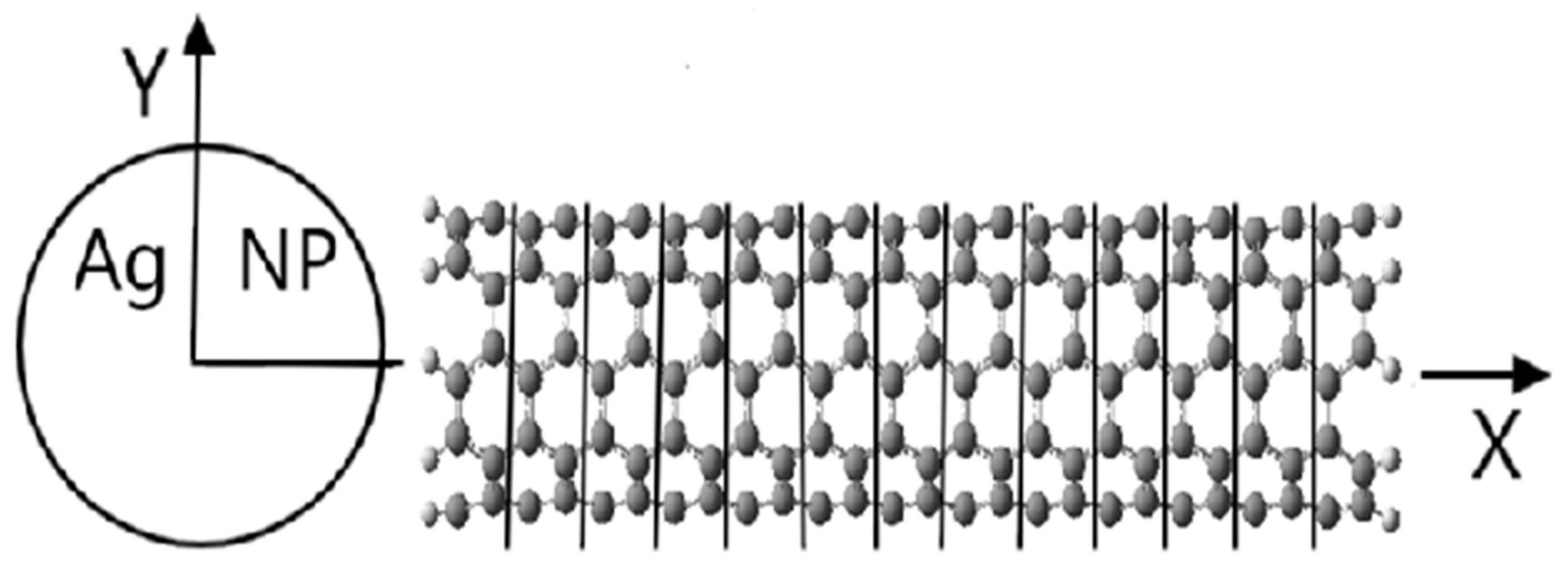


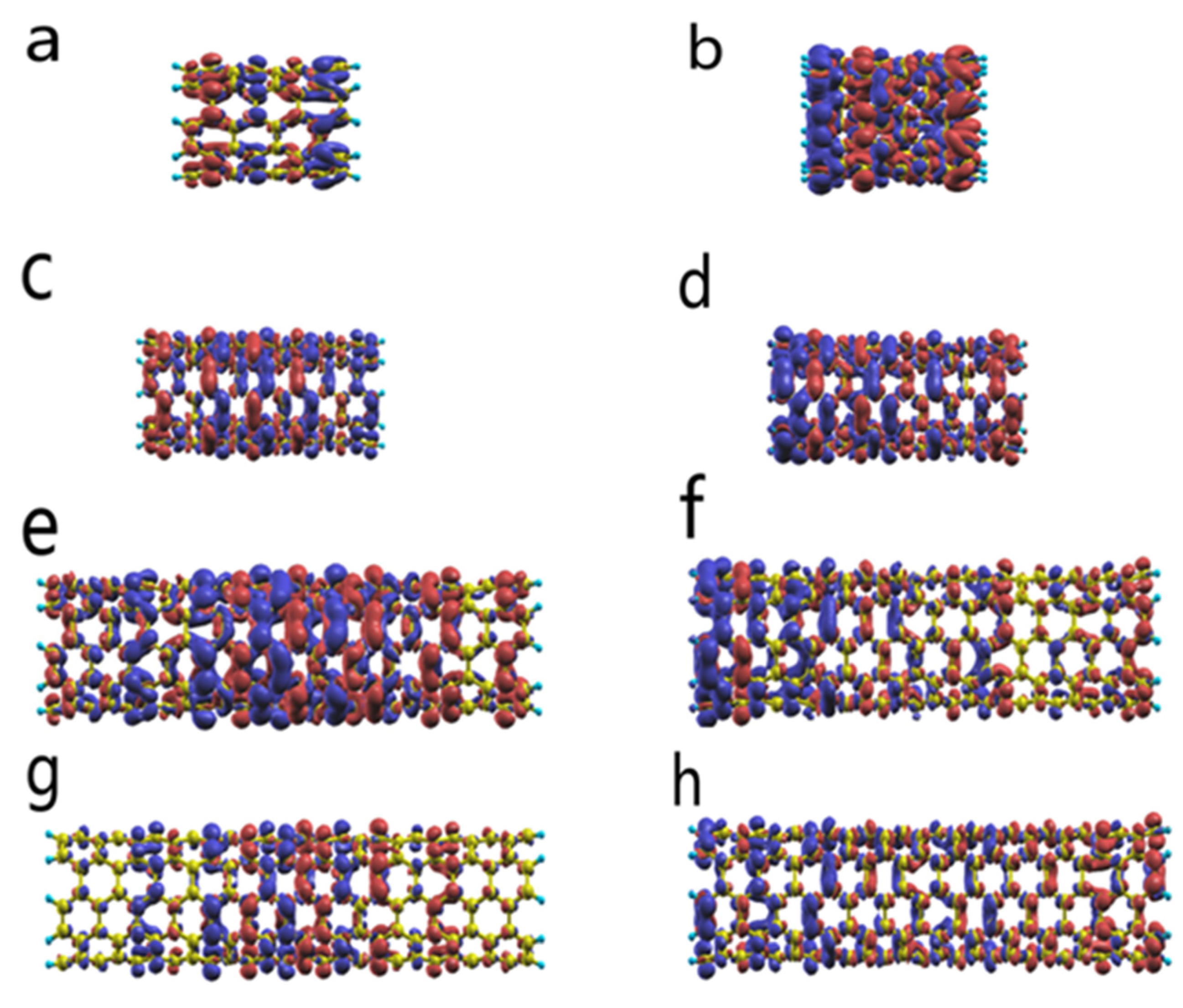
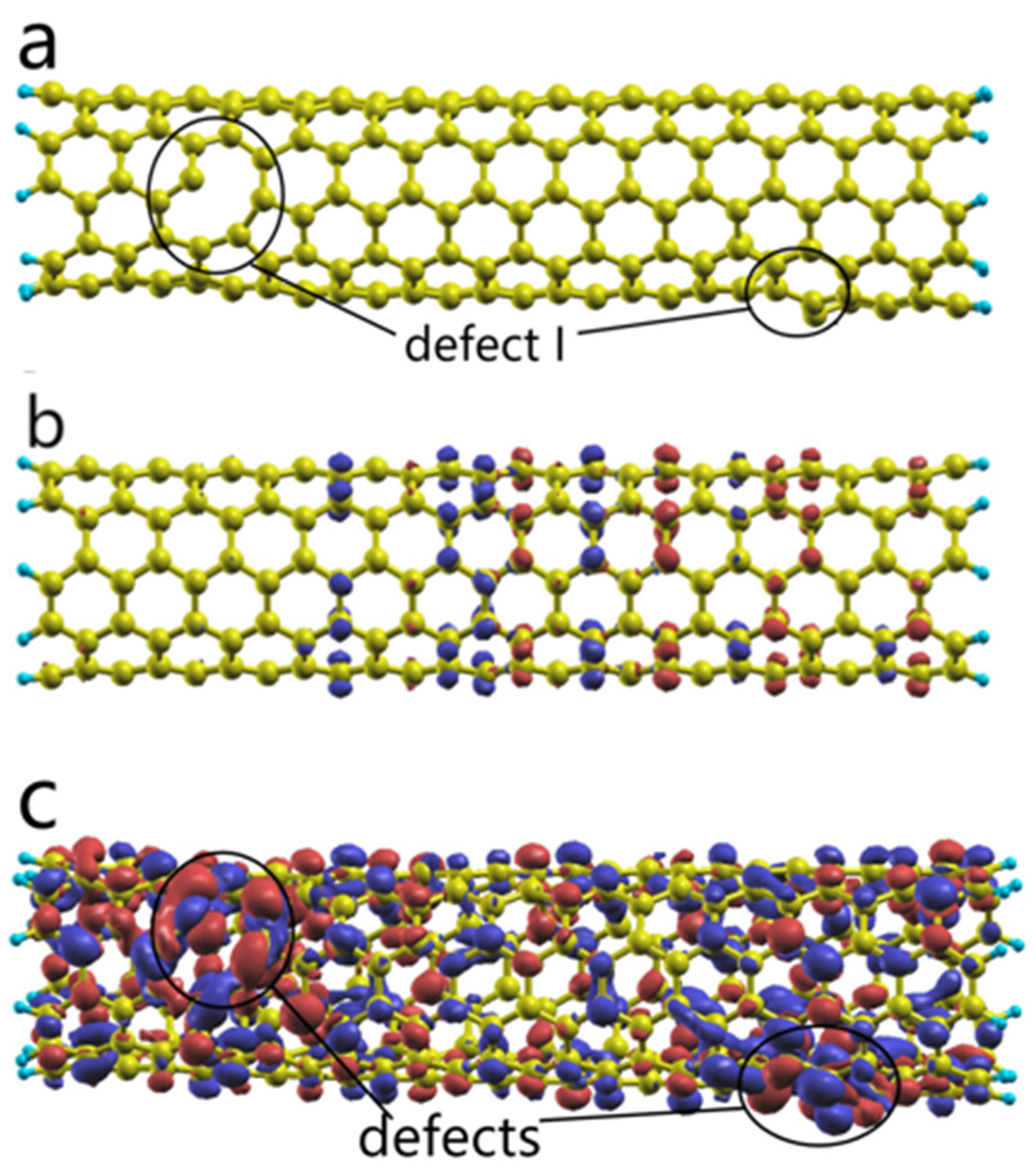
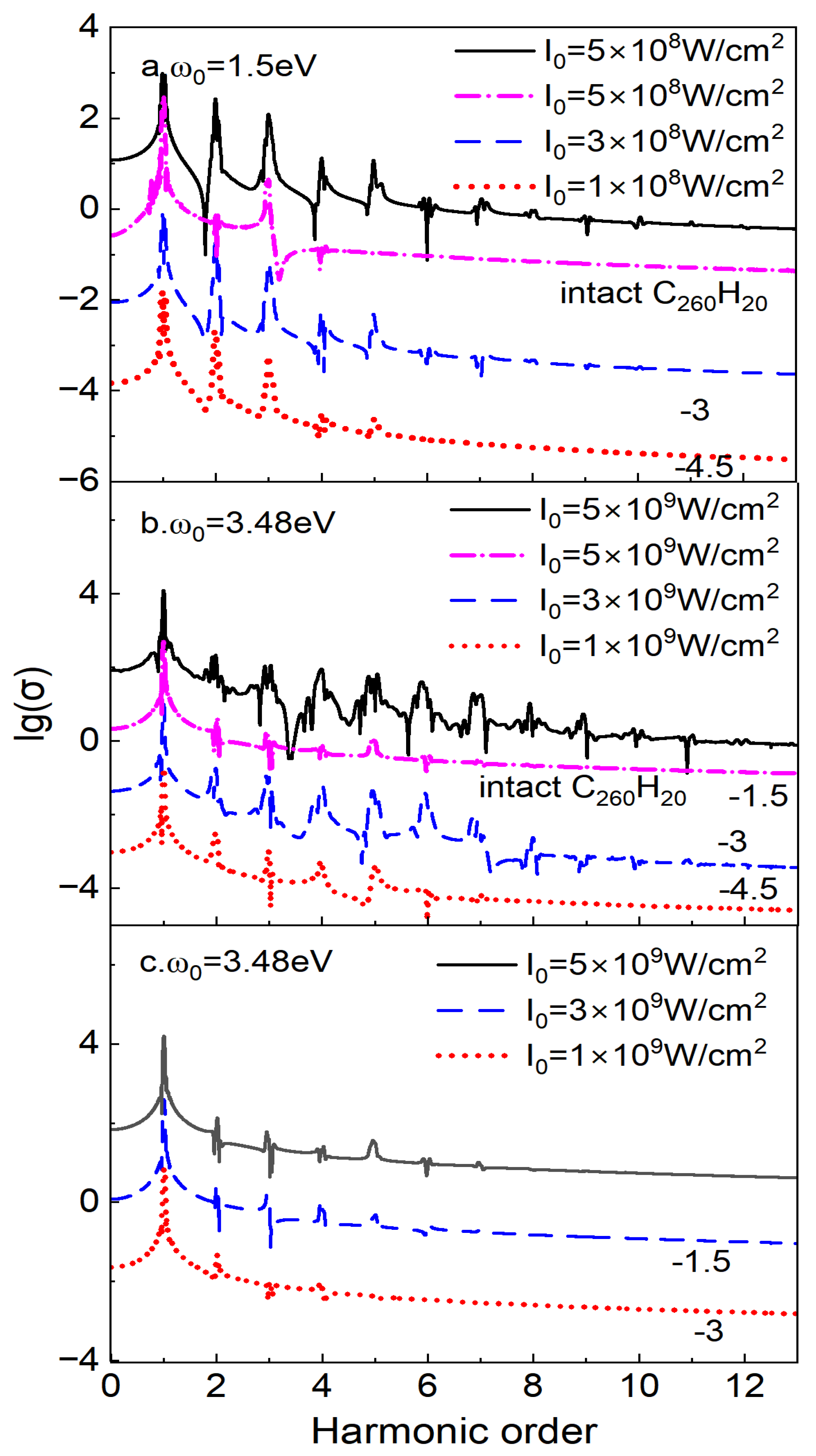
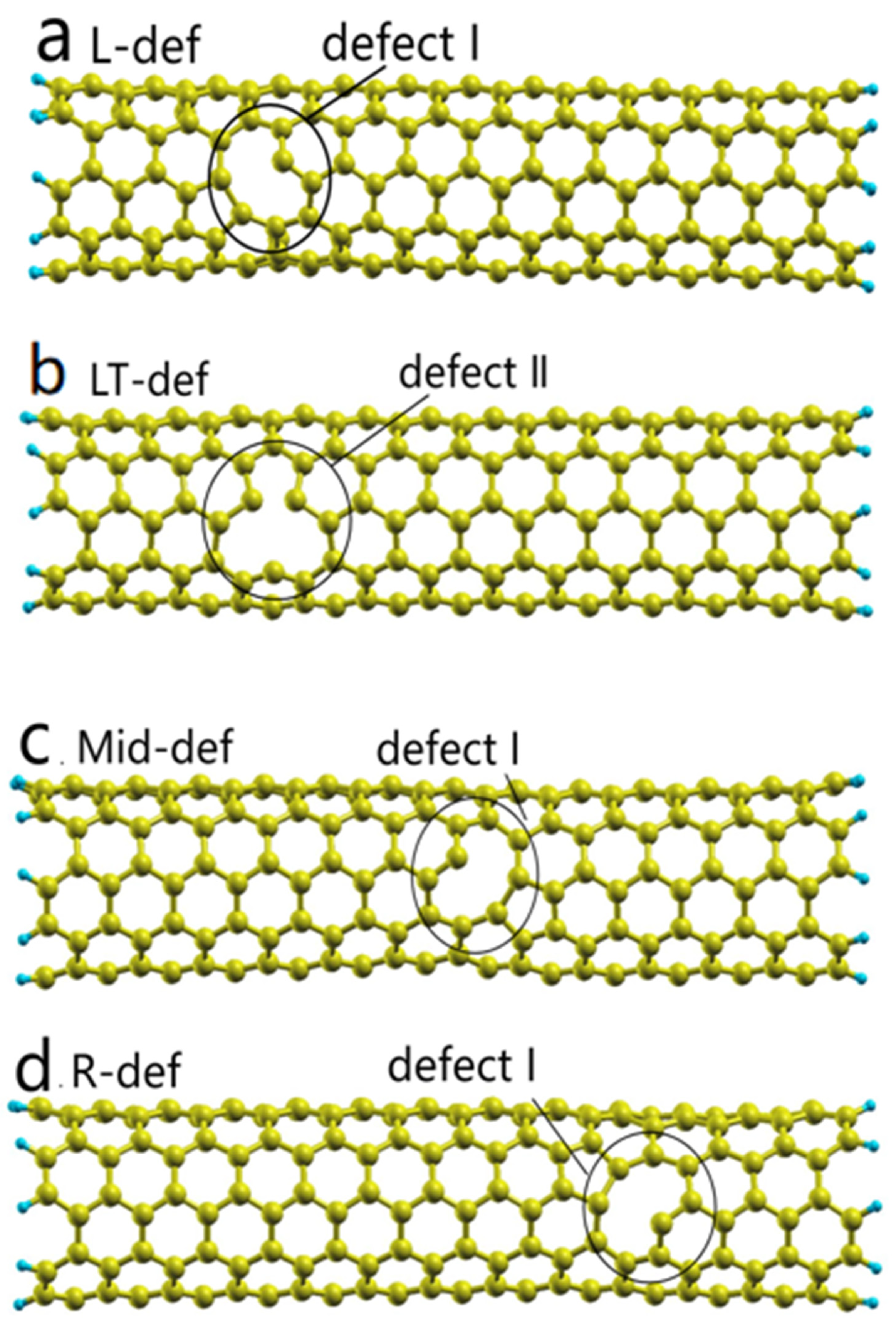
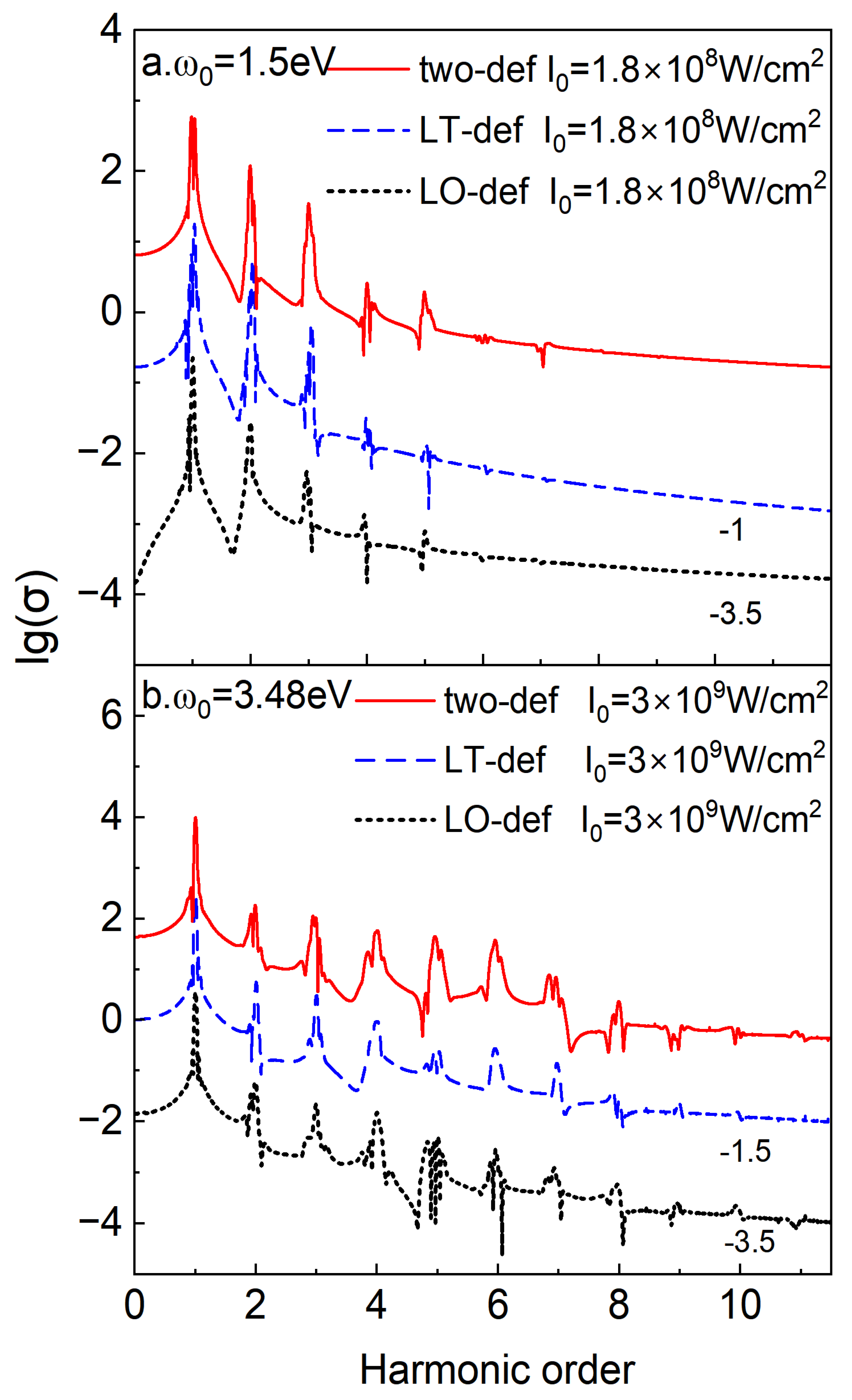
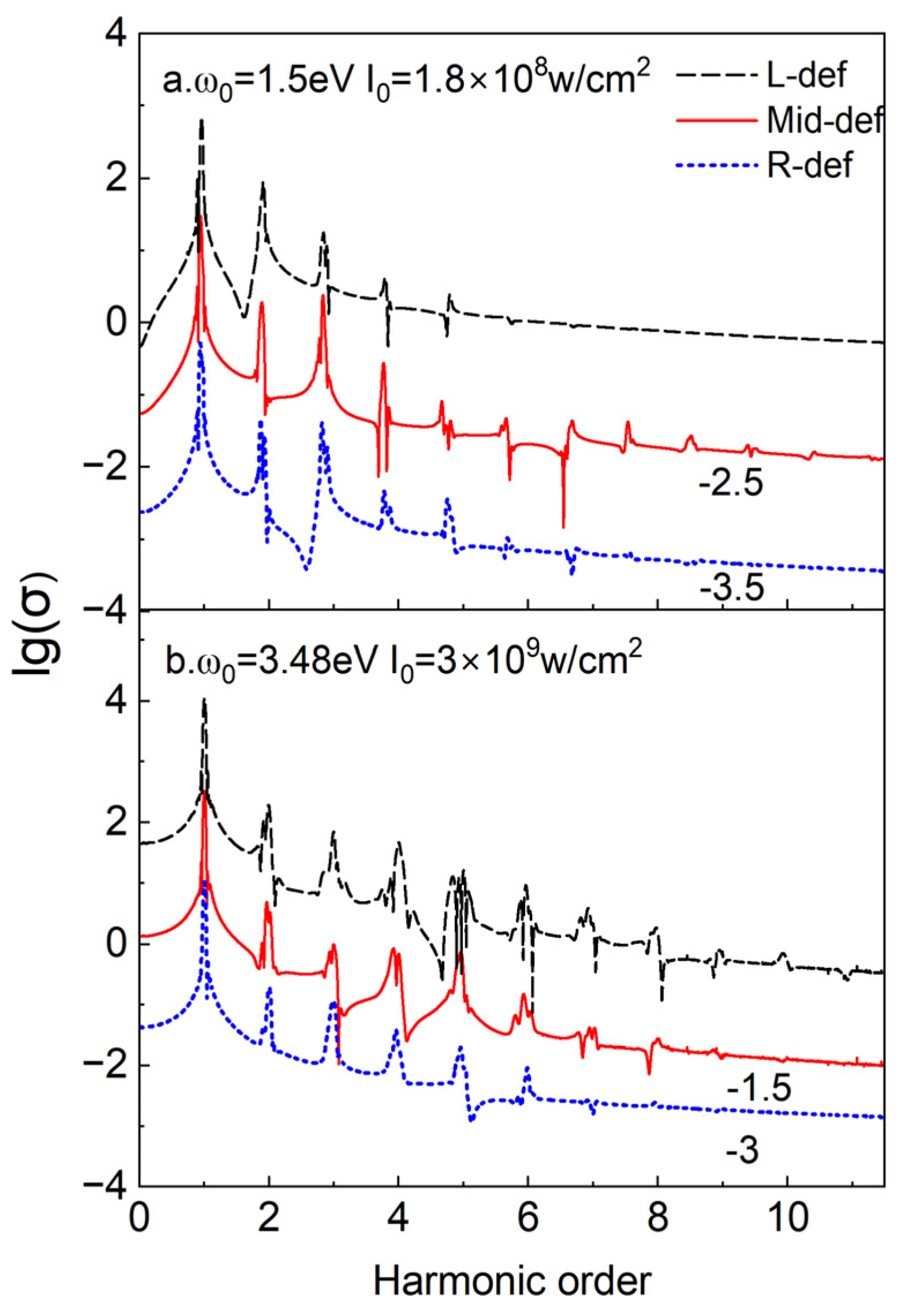
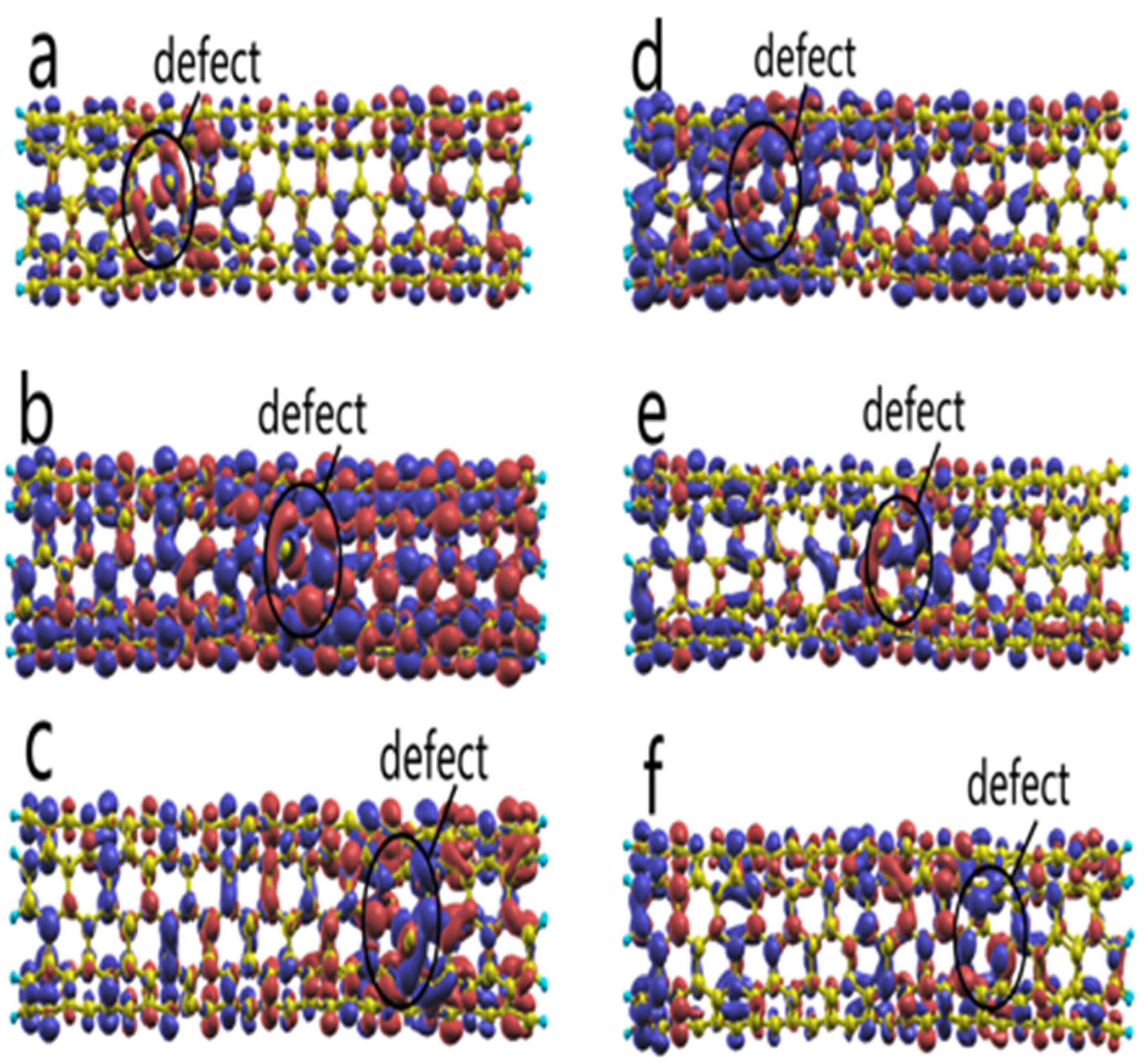
Disclaimer/Publisher’s Note: The statements, opinions and data contained in all publications are solely those of the individual author(s) and contributor(s) and not of MDPI and/or the editor(s). MDPI and/or the editor(s) disclaim responsibility for any injury to people or property resulting from any ideas, methods, instructions or products referred to in the content. |
© 2024 by the authors. Licensee MDPI, Basel, Switzerland. This article is an open access article distributed under the terms and conditions of the Creative Commons Attribution (CC BY) license (https://creativecommons.org/licenses/by/4.0/).
Share and Cite
Hu, Q.; Yang, K.; Li, Q.; Sun, J.; Ding, Z. Plasmon-Enhanced High-Order Harmonic Generation of Open-Ended Finite-Sized Carbon Nanotubes with Vacancy Defects. Crystals 2024, 14, 115. https://doi.org/10.3390/cryst14020115
Hu Q, Yang K, Li Q, Sun J, Ding Z. Plasmon-Enhanced High-Order Harmonic Generation of Open-Ended Finite-Sized Carbon Nanotubes with Vacancy Defects. Crystals. 2024; 14(2):115. https://doi.org/10.3390/cryst14020115
Chicago/Turabian StyleHu, Qi, Kun Yang, Qiuju Li, Jin Sun, and Zongling Ding. 2024. "Plasmon-Enhanced High-Order Harmonic Generation of Open-Ended Finite-Sized Carbon Nanotubes with Vacancy Defects" Crystals 14, no. 2: 115. https://doi.org/10.3390/cryst14020115





